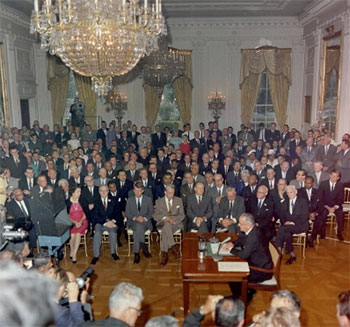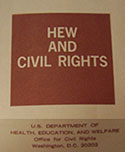Civil Rights Campaigns (1955-1980, Section 7)
The civil rights protests and integration in Houston took place against a backdrop of dramatic and transformative national events in the 1950s and 1960s. Across the South, millions of African-Americans challenged the racial status quo through boycotts, nonviolent protests, and legal challenges and helped achieve the broadest social reforms in U.S. history. For example, the bus boycott in Montgomery, Alabama in 1955 and 1956 brought Rosa Parks and Martin Luther King, Jr. to national attention. The U.S. Supreme Court ruled in 1956 that Alabama’s racial segregation laws for buses, and by implication all similar state laws, were unconstitutional. Dr. Levi V. Perry recalls that the day he read the newspaper story about the court decision, he proudly sat at the front of the bus in Houston just because he knew that he could.
On February 1, 1960, four students from the all-black North Carolina Agricultural & Technical College sat down at a segregated lunch counter at the Woolworth’s store in Greensboro. Hundreds of other students soon joined the spirit of the protests in Greensboro as the sit-in movement spread to 54 cities in nine states.
In Houston, in March 4, 1960, TSU students “organized the city’s first sit-in protest at the Weingarten grocery store counter.” 1 Similar peaceful demonstrations occurred across the city. Dr. Natalie Carroll’s father, Dr. Carl Mark Carroll, Jr., was an active member of the Houston Medical Forum at this time. She recalls that the students asked the HMF to play an important role with respect to the sit-ins; the doctors readily agreed. HMF members pooled money to provide bail and to cover court costs for demonstrators who were arrested.
Dr. Paris Bransford, a native of Huntsville, Alabama who became a surgeon and later moved to Houston, attended Meharry Medical College between 1959 and 1963. He recalls that while he was a medical student, professors at Meharry similarly took out second mortgages on their homes to provide bail when their students protested segregation in Nashville. “I read the paper the next day that those guys had put their houses up for mortgage in order to keep those kids out of jail.” 2
In June 1960, local actors developed a plan to aid the integration of facilities in Houston. Hobart Taylor was a political ally of Lyndon Johnson and a black entrepreneur who made a fortune operating a black taxicab business and in real estate. John T. Jones was the white publisher of the Houston Chronicle. Bob Dundas was the white vice-president of Foley’s department store that had experienced a boycott earlier in the year. These three Houstonians convinced seventy stores in downtown Houston to desegregate quietly over a weekend by arranging for a media blackout that guaranteed no confrontations and no bad publicity.
In December 1960, the U.S. Supreme Court ruled in Boynton v. Virginia (364 U.S. 454 (1960) that state laws segregating waiting rooms and restaurants in rail and bus stations violated the federal Interstate Commerce Act. Two months later, TSU students tested this new precedent by launching a series of sit-ins at the lunch counter at Houston�s Union Station every Saturday for six weeks.
They were joined by a handful of white students from other universities. Dr. Robert Bacon recalls that on Saturday evenings HMF members arrived at the police station with local lawyer, George Washington, Jr., to bail out the students. In an effort to frustrate the protesters and their supporters, the police never released the students en masse, forcing the HMF members and Mr. Washington, who did most of his work pro bono, to wait until 6 a.m. or 7 a.m. the next morning to complete their task. (Lawyers perform pro bono work without compensation for the public good.) In June 1963, Hobart Taylor organized another media boycott to quietly desegregate Houston�s theaters and restaurants.
Building on the preliminary success of such protests and nascent voting campaigns across the South, civil rights activists organized the famous March on Washington in August 1963. More than a quarter of a million people of all races came to the nation’s capital and peacefully protested for jobs and freedom. The march played an important role in Congress’s passage of the Civil Rights Act of 1964 and the Voting Rights Act of 1965.
Citations
- William Henry Keller, Make Haste Slowly: Moderates, Conservatives, and School Desegregation in Houston (College Station: Texas A & M University Press, 1999).
- Dr. Paris Bransford, interview by Ramona Hopkins, 17 April 2007, Houston, TX, audio and video recording.





